Hare Krishna – Hare Rama.
It sounds almost like “Christ is Risen – Truly He is Risen.”
Hare Krishna – Hare Rama: A Familiar Sound
Hare Krishna—Hare Rama. It sounds almost like “Christ is Risen—Truly He is Risen.” I embarked on a journey through India with only the vaguest understanding of Hinduism.
I remember how I used to react when I occasionally crossed paths with groups of Hare Krishnas: I’d wave off this strange barefoot bunch, draped in yellow-orange cloth with flowers around their necks — a ragtag troupe of eccentrics. Somewhere in the back of my mind, I also carried the typical cultural baggage: murmurs about cults, brainwashed foreigners, and tragic tales of people caught in the Krishna web. Not very respectful, I admit. But there it is — words, once spoken or thought, have a life of their own and won’t tolerate insincerity.
Still those ideas never really took root in me. They were more like a thin “cultural” crust, fragile enough to crack at the first gust of curiosity. As the modern meme goes — it isn’t very easy.
And irony had its moment: for my trip to India, I dressed entirely in saffron and gold — not intentionally, but enough to make my friends in the Bali airport chuckle. “Color of the maharaja,” Mikola noted with a smile.
So, that’s the baggage I brought — mental and otherwise — when I arrived as a guest in Krishna’s world.
Annapurna: A Devotee’s Warm Welcome
We reached Vrindavan in the evening of the second day, having taken a taxi from Delhi. It was late—pitch dark. Even the streetlights were off. On the main road along the Yamuna River — one of India’s sacred rivers, born in the Himalayas and joining the Ganges at Prayagraj (where we’d head in a few days for the Maha Kumbh Mela) — lay rows of beggars wrapped in layers of filthy cloth, sleeping on grimy mattresses. Trash was everywhere. Cows wandered about with stoic indifference, and gangs of monkeys prowled the alleyways on our way to the ashram. In short: the first impression was bleak, not unlike the Tibetan quarter of Delhi.
We wandered a long time through unlit backstreets, trying to find the entrance to the ashram, until we were rescued by a young woman — Annapurna, a Russian girl who had devoted her life to Krishna.
Her name, Annapurna, given to her in service, means “She who feeds abundantly.” And indeed, we were greeted with open-hearted warmth. She even gave up her room for Nastya and me — a true wardrobe-turned-bedroom with dozens of colorful saris and a large hive of bees, both alive and dead, cozily nestled on the balcony.
It was late. We needed rest before the impressions the next day would bring.
Life Inside the Ashram
Shri Chaitanya Saraswat — the ashram where we stayed — belongs to a branch of Vaishnavism based on devotion to Mahavishnu (the Great Vishnu) and his avatars Krishna and Rama. I don’t aim to provide a deep analysis of Hindu sects here — that’s been done thoroughly and professionally elsewhere. I see myself more as an outside observer, admiring the many expressions of human faith and the varied paths that lead to it.
The next morning unfolded slowly over breakfast in the ashram.
The conversation flowed easily. Annapurna spoke passionately about the ashram’s ritual life, about love and the brotherhood of the “devotees.” She shared, sincerely and with almost childlike joy, how her life had transformed and filled with meaning after she moved into the ashram, which had become a true home for her.
After breakfast, I was invited to dress more fittingly for the role. Annapurna pulled out a beautiful cream-colored sari from a suitcase with a burgundy and gold border. Six meters of fabric, which in her hands — she was an artist and set designer by secular profession — turned into a stunning garment.
I felt like Queen Anne of Austria from The Three Musketeers, somehow transported to India.
Soon, our growing group flowed out of the ashram to explore the city of Krishna and Rama.
Vrindavan’s Monkey Mafia
The morning was sunny, and cows were still wandering through the centuries-old piles of uncollected garbage. The monkey gangs were even livelier after their night’s rest, and the clear instructions we received at the ashram regarding these racketeers were very timely.
Monkeys in Vrindavan essentially thrive on the carelessness of locals and tourists. Glasses, phones, jewelry, shoes left at temples, fruits, hats, and other items instantly become the prey of these supersonic monkeys. Don’t think about winning this battle — the monkeys will surely beat you.
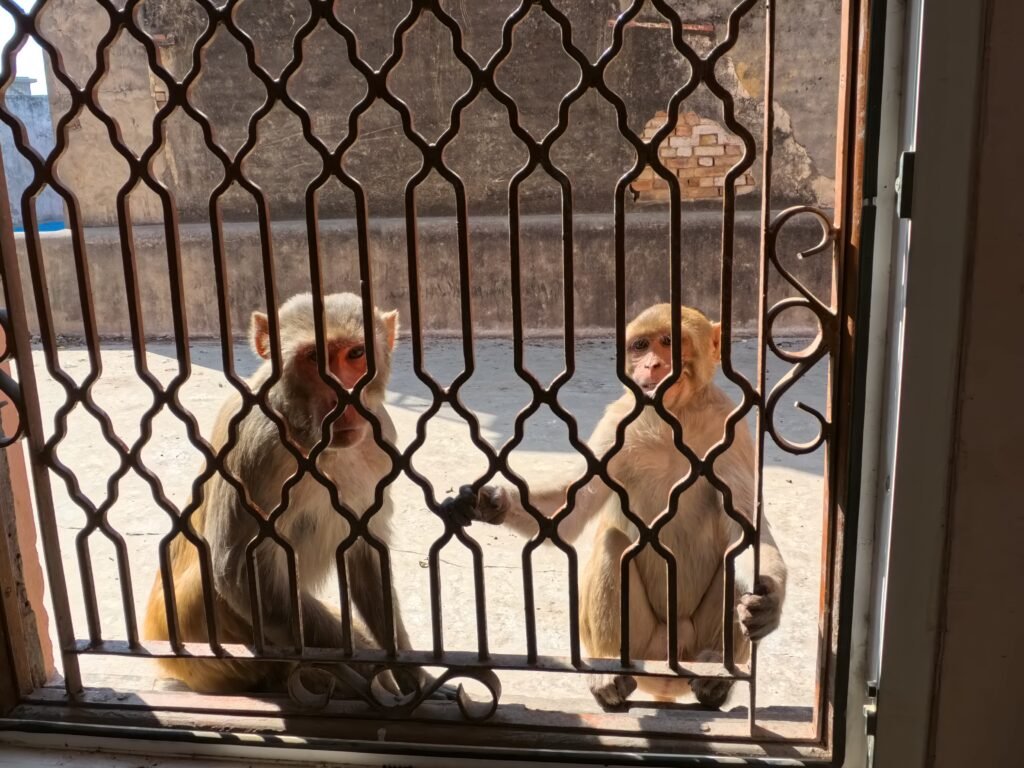
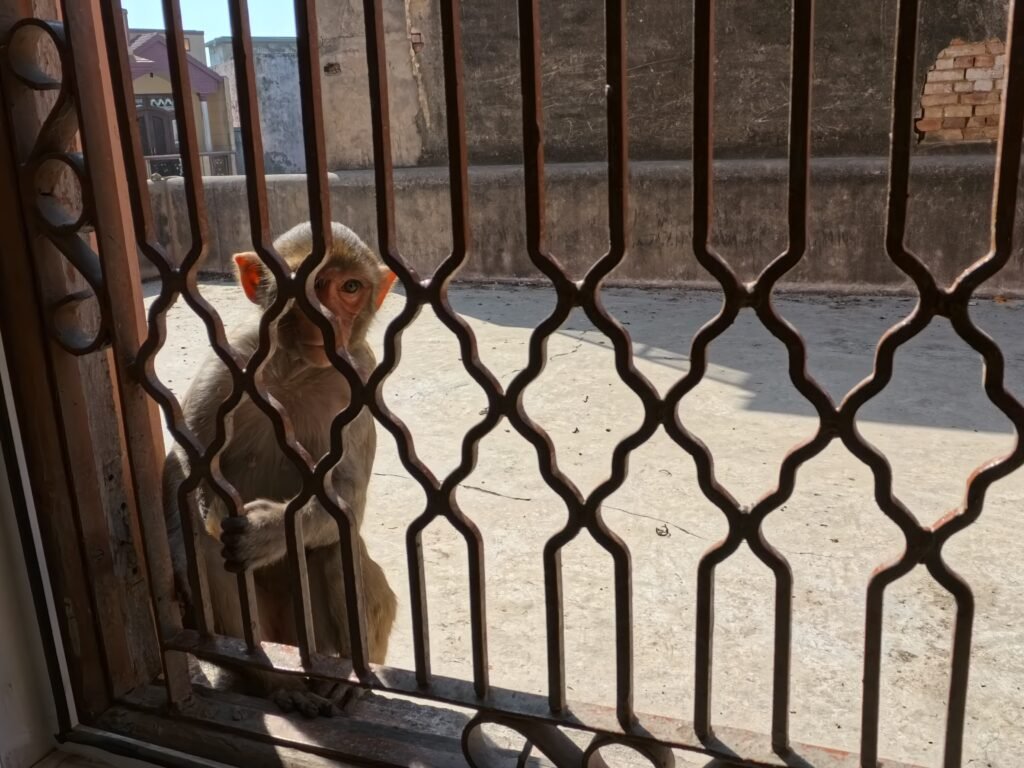
To try to get your belongings back, you will have to pay a ransom—a packet of juice, fruit, or some other offering. Of course, the result is not guaranteed.
I personally witnessed a scene where a monkey happily accepted the offerings while sitting on the roof of a low building, where it was practically impossible to reach it, and had no intention of returning a distracted owner’s phone.
According to Mykola’s recollections, he once had to climb onto a roof with a stick to snatch back a phone stolen from Nastya. In that battle, the monkey suffered a crushing defeat. If you ever visit Vrindavan, perhaps you will remember these local gang features.
But let’s get back to us.
A Pilgrimage in Saris
The women of our group, dressed in saris, accompanied by a devotee wearing clothing reminiscent of Palestine in the time of Jesus Christ, Mikola, and Kirill, moved smoothly through the chaotic streets of Vrindavan.
Looking at our group from the outside, I couldn’t stop laughing. The resemblance to the first Christians was so strong that the external decorations took quite plausible shapes. This looked especially convincing due to the seriousness with which Annapurna and her colleague preached.


I often provoked this seriousness myself, as I sincerely wanted to understand why our friends led from the ashram to such an unusual faith form, unfamiliar to my mind.
Starting in Vrindavan, my analytical brain received insufficient arguments to comprehend what was happening. I was in constant cognitive dissonance, which only grew during our journey.
I can’t help but warmly remember Kirill, who patiently and delicately illuminated many things for me. He made concepts understandable and wrapped them in familiar semantic and conceptual forms.
Kirill became for me on this trip a close friend, an intellectual-spiritual twin, a guide through the labyrinth of Hinduism from the perspective of reason and logic. Many hours of our conversations will remain forever in my memory and heart.
While Nastya and Mikola filled our journey through Vrindavan with dozens of religious and mythological stories, my brain kept searching for some rational meaning in all the surrounding mystery — or better yet, in the religious bacchanalia.
I lost count of how often we took off our shoes upon entering various sacred places. My friends would bow deeply before countless unknown avatars of gods. Fortunately, the pilgrimage program was interspersed with stops to satisfy bodily needs for rest and food.
Lassi: Divine in a Clay Cup
Here, I can’t help but pause to mention the divine lassi—something between kefir and yogurt—made with fruits, nuts, honey, and other delights. It is served in clay cups that break after one use and return to their original state: clay.

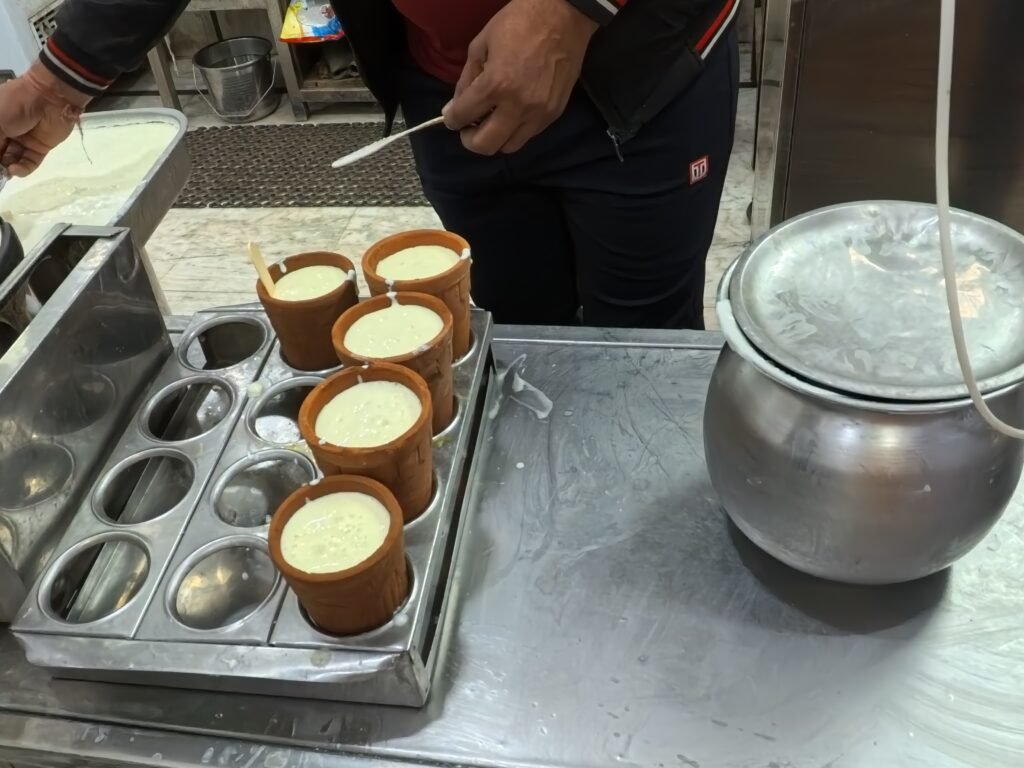
India, with all its contradictions, occasionally surprises with ecological wonders — like this ancient preserved tradition. Lassi, made from the milk of sacred cows, is itself a gastronomic masterpiece.
Temples of Vrindavan
Sri Ranganath Ji
Vrindavan is not just a city but a whole world, soaked in Krishna’s history.
According to legends, this is where he spent his childhood, like Christ in Nazareth, playing the flute, dancing with the gopis (milkmaids), and joking with Radha (Krishna’s eternal beloved).
There are more than five thousand temples here, two of which we visited. On the banks of the Yamuna, kirtans resound, lights of arati burn, and time flows differently — as if past, present, and eternity have merged into one place.
This is how the city sounds in the hearts of the faithful. And indeed, the primary name on everyone’s lips is Krishna. Strangers greet each other exclusively with the words “Hare Krishna — Hare Rama,” glorifying the names of God.
This mantra can be translated as “O all-attractive, O all-joyful God, O spiritual energy of God!” In Gaudiya Vaishnavism, it is believed that repeating the “Hare Krishna” mantra allows one to attain the highest perfection in life—“pure love for Krishna.”

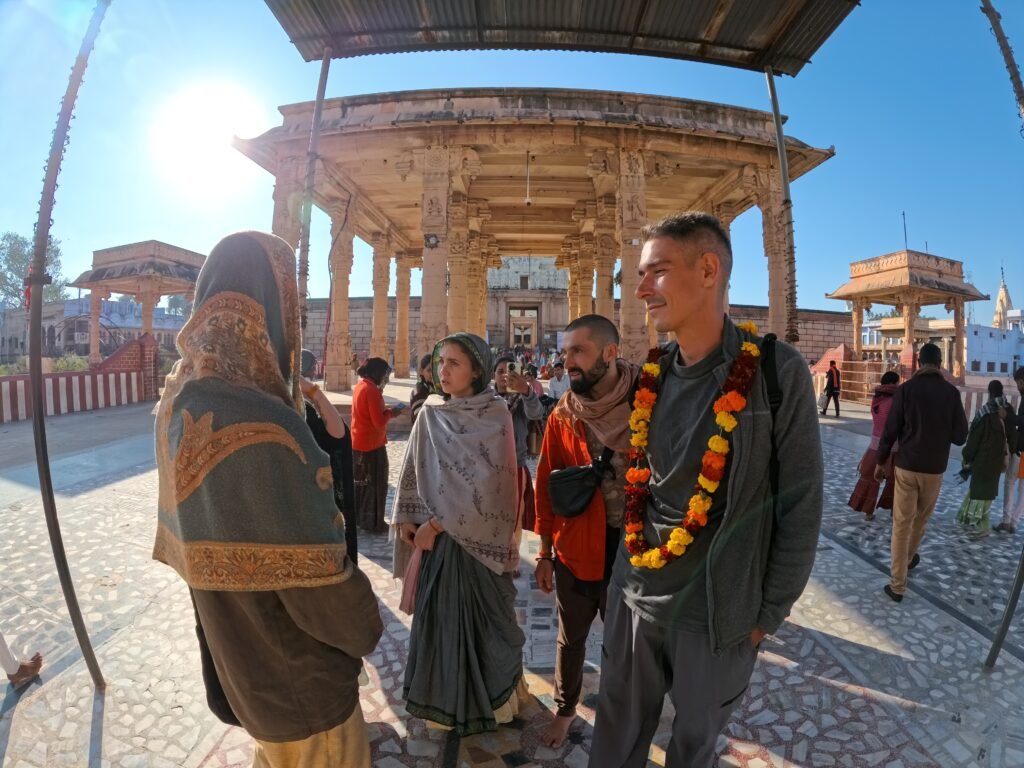
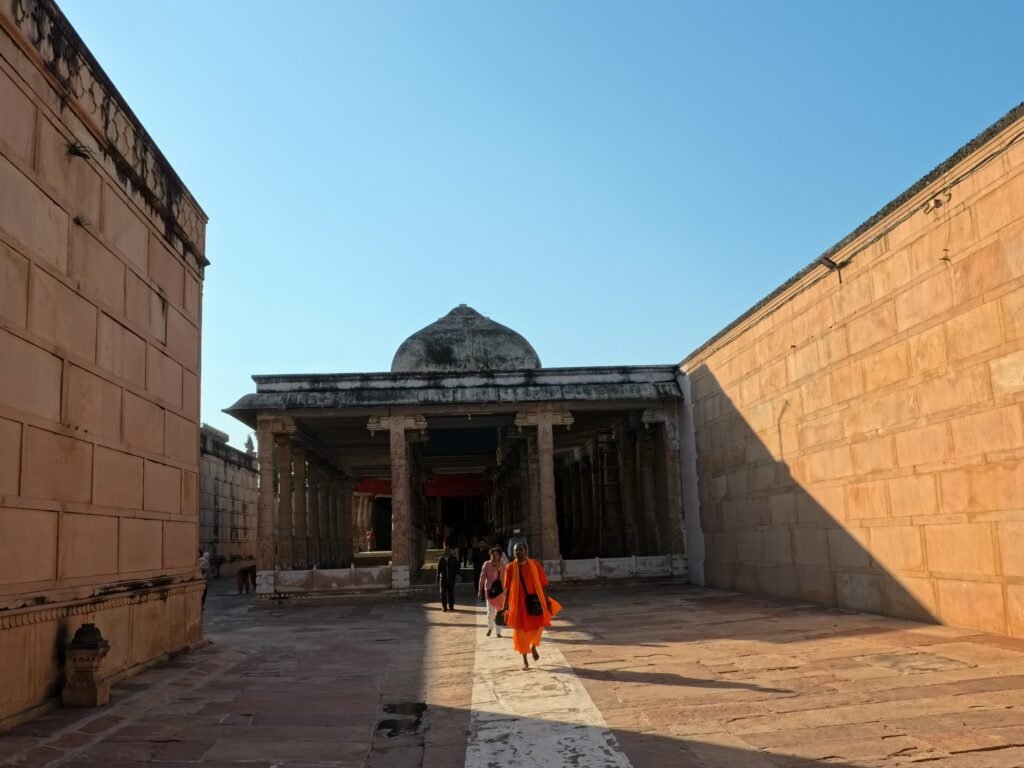

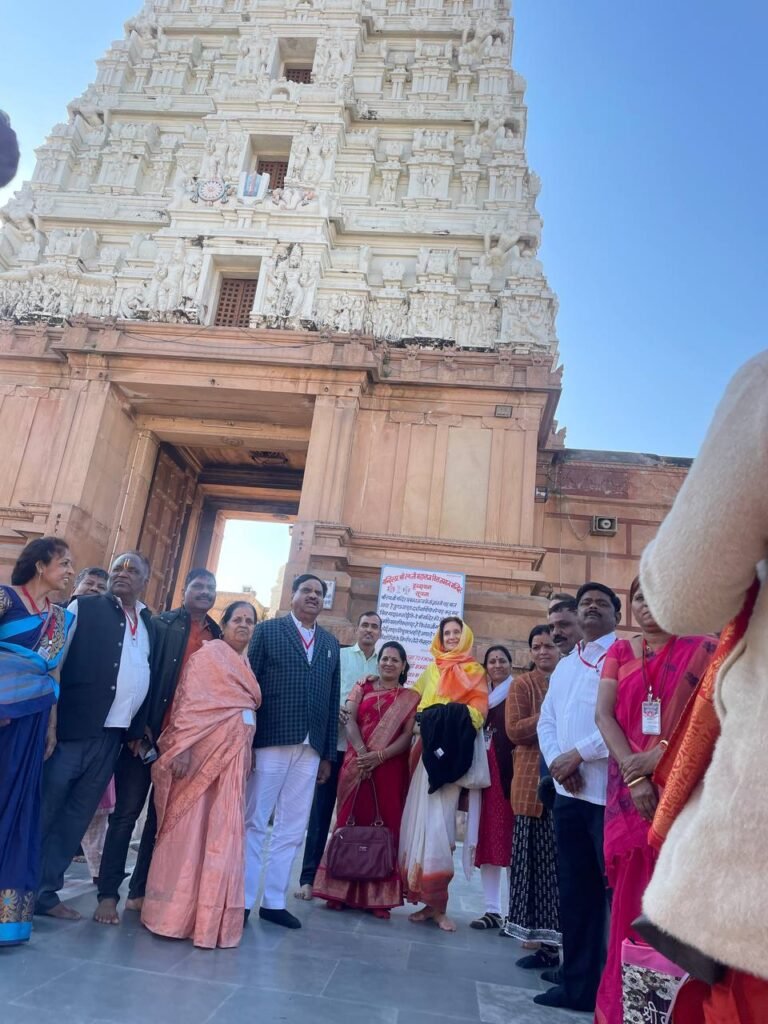
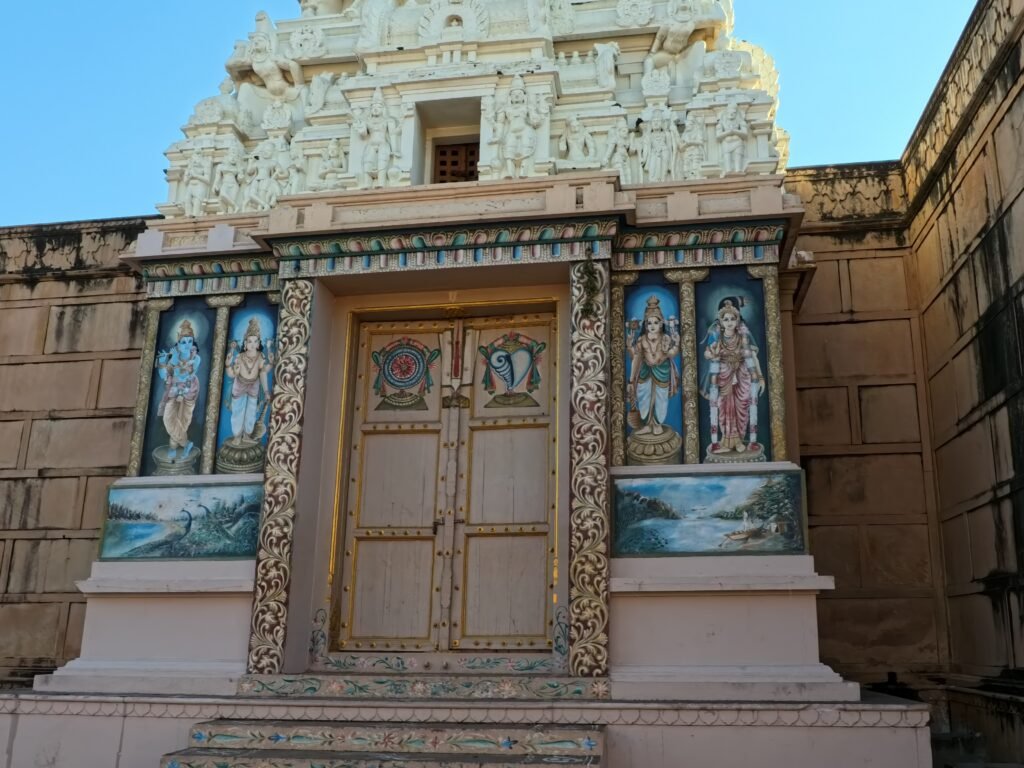
Our acquaintance began with Sri Ranganath Ji Mandir, one of the most unusual in Vrindavan. It stands out not only for its scale but also for its rare Dravidian architecture: tall gopurams, massive columns, spacious courtyards—like a piece of South India transplanted into Krishna’s city.
The temple’s main deity is Ranganath, a form of Vishnu reclining on the serpent Shesha in the Ananta-Shayana pose. This temple unites two worlds of Vaishnavism: strict devotion to Vishnu and tender love for Krishna.
There is a special silence here — as if the space freezes in anticipation of divine awakening.
Here we were surrounded by the attention of Indian tourists — everyone eager to take photos with white foreigners. On one photo, according to my friend, our group picture looked like a high-level meeting of representatives of friendly nations, reminiscent of our Soviet childhood.
Vrinda Kunja Ashram and Meeting Maharaj
Next, we visited another ashram — Vrinda Kunja — in the Gaudiya Vaishnavism tradition, headed by a charismatic German. Thanks to him, we would comfortably stay in Prayagraj for the Maha Kumbh Mela.
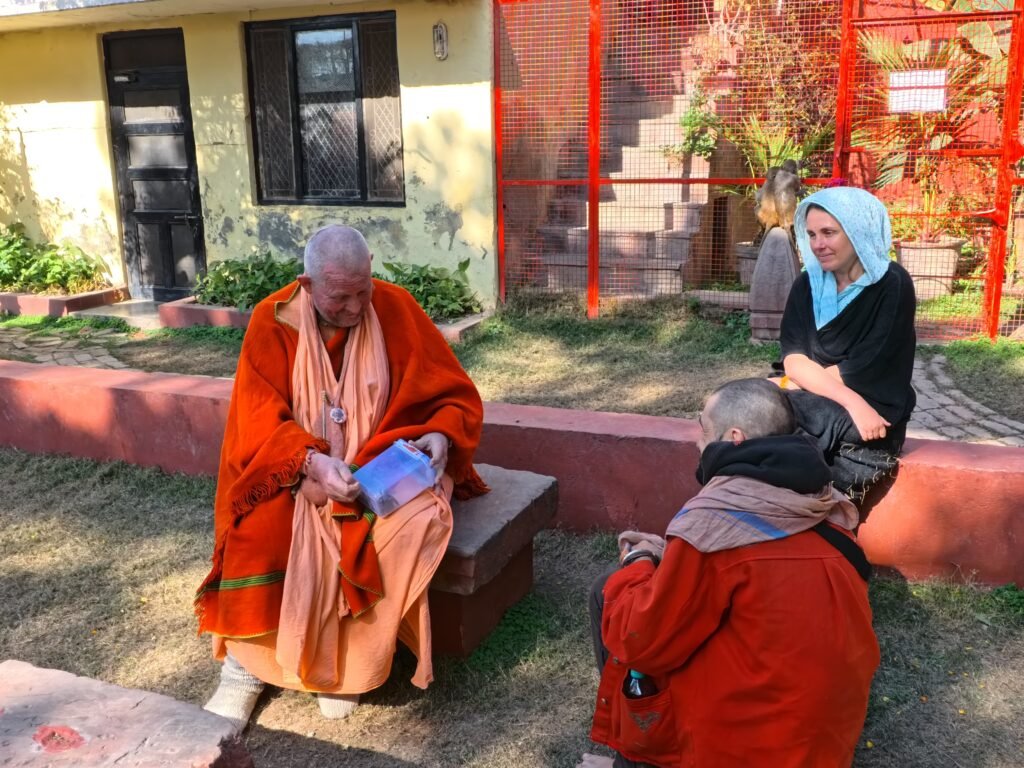
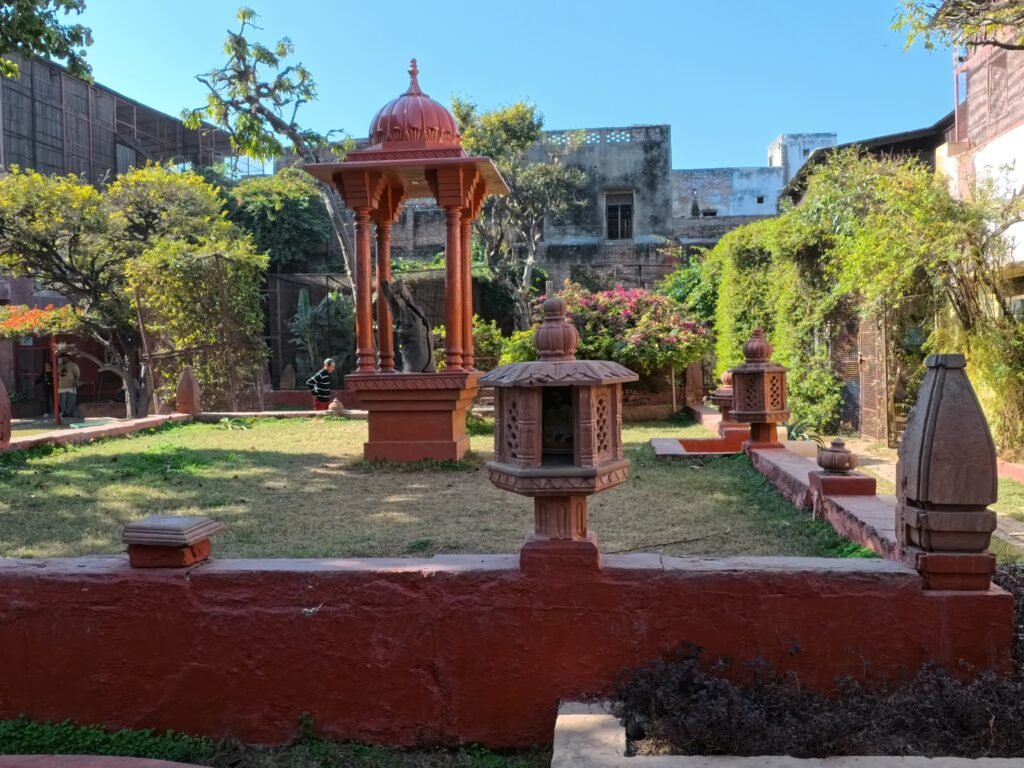
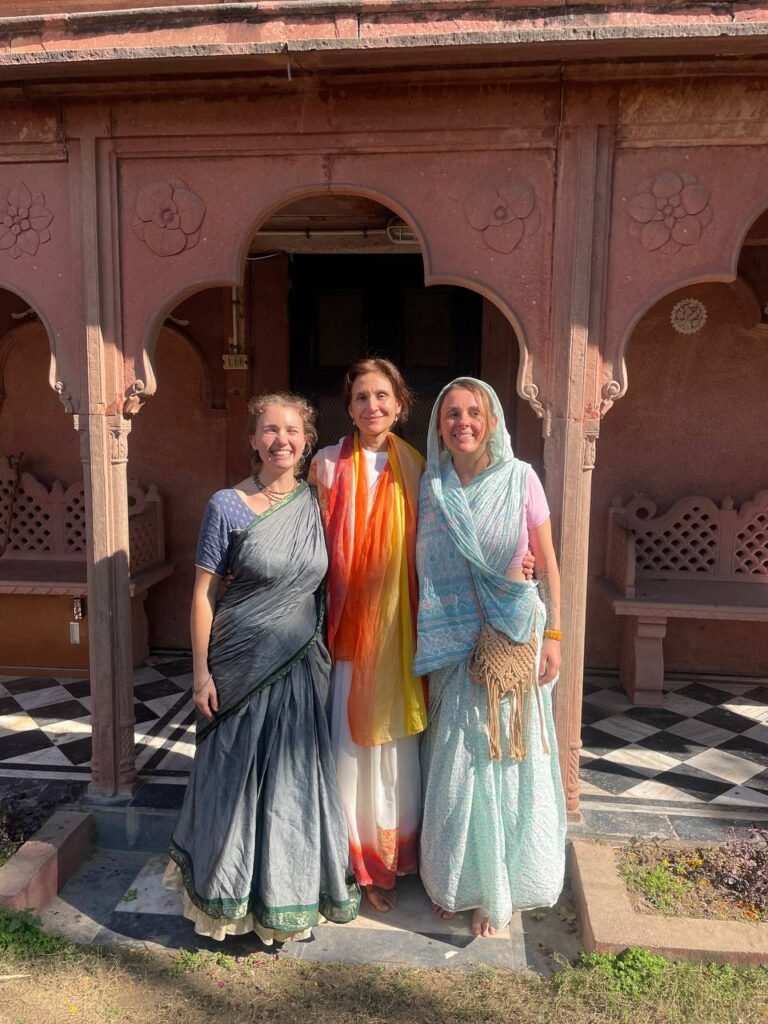
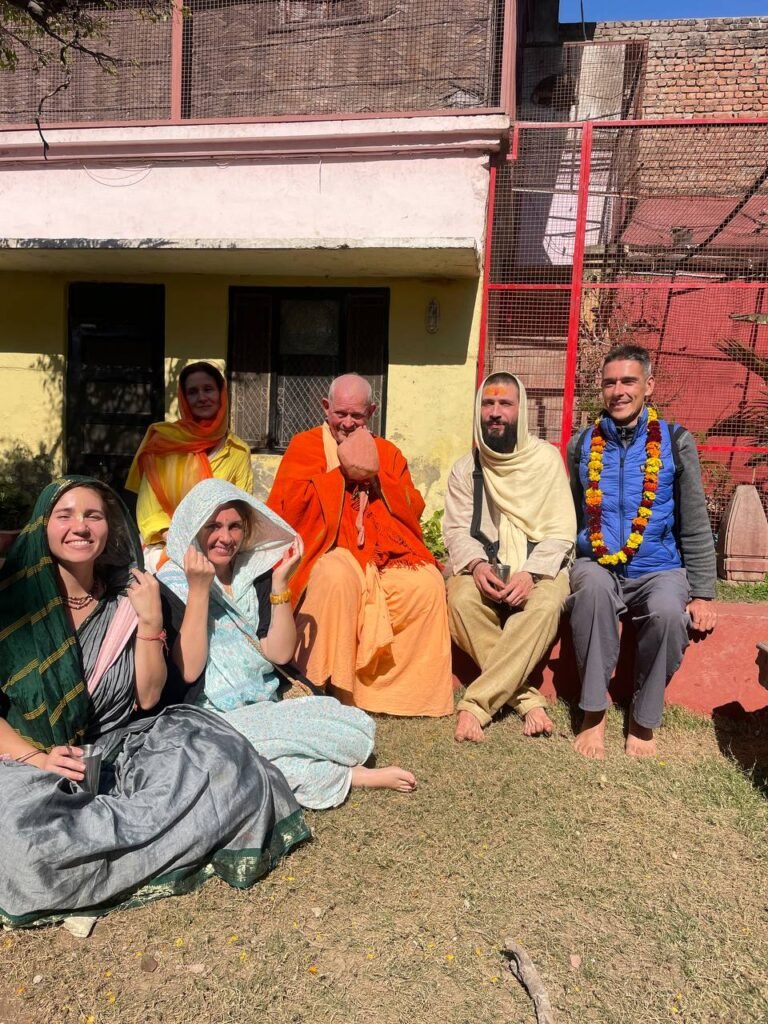
The Vrinda Kunja Ashram is a quiet corner of Vrindavan, near the ancient Vrinda Kund — a sacred pond named after the goddess Tulasi. It was restored at the end of the 20th century and is a refuge for spiritual seekers.
With particular reverence and admiration, Nastya looked at Maharaj and several times repeated that we had a unique opportunity to ask questions. The only question I managed to produce: how to open the heart. “Faith,” Maharaj replied with a sly smile.
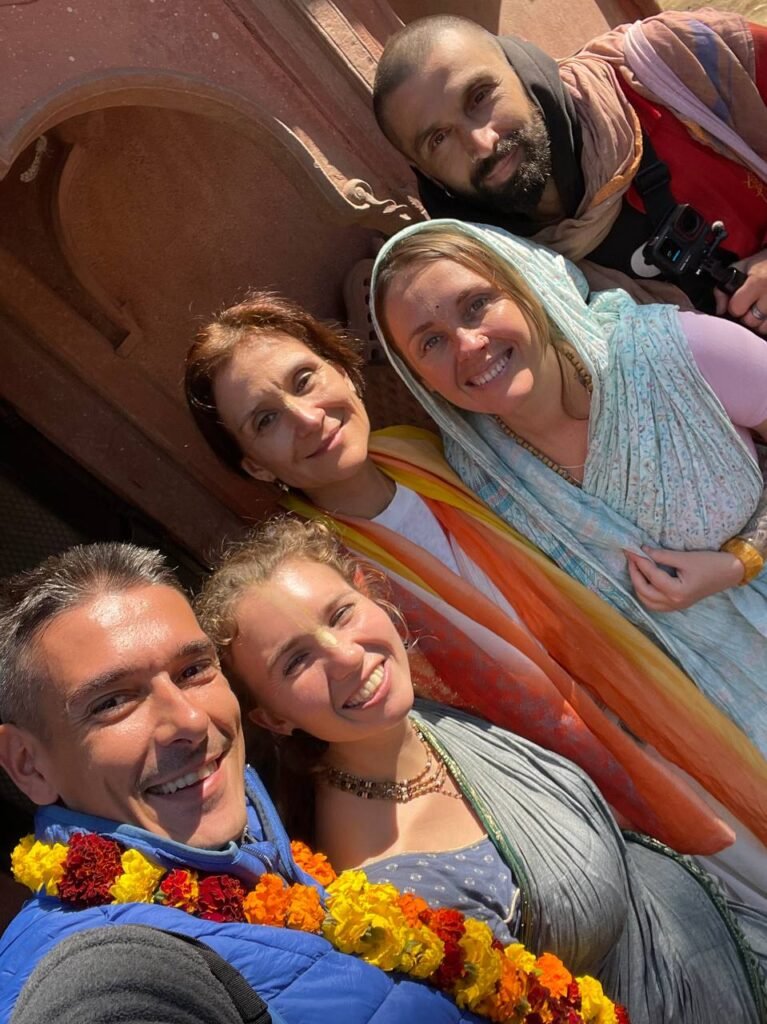

Again, faith. Thank God I could reduce the pathos by exchanging friendly remarks with Kirill, whose bright mind I was beginning to value more and more.
Sacred Silence Above the Yamuna: Discovering Madan Mohan Temple
After a magnificent lunch — as often happens in ashrams — we went to the banks of the Yamuna, where monkeys roamed and cows grazed peacefully. Sprinkled with water from the holy river, sprayed by my dear guides, we visited another temple.


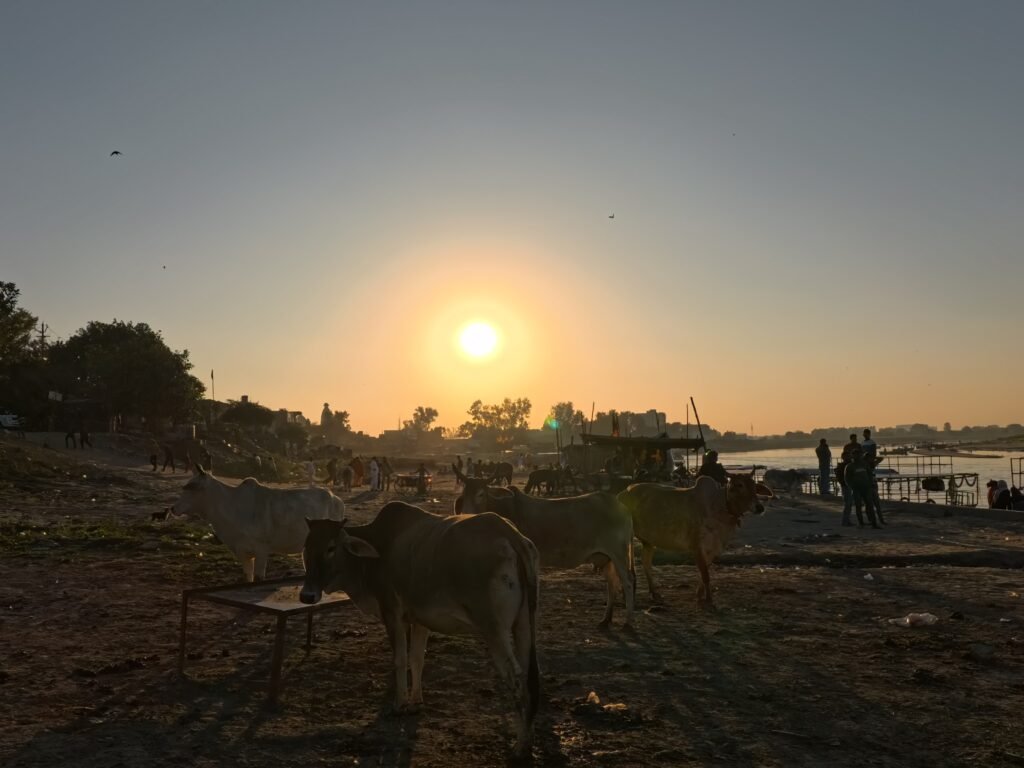
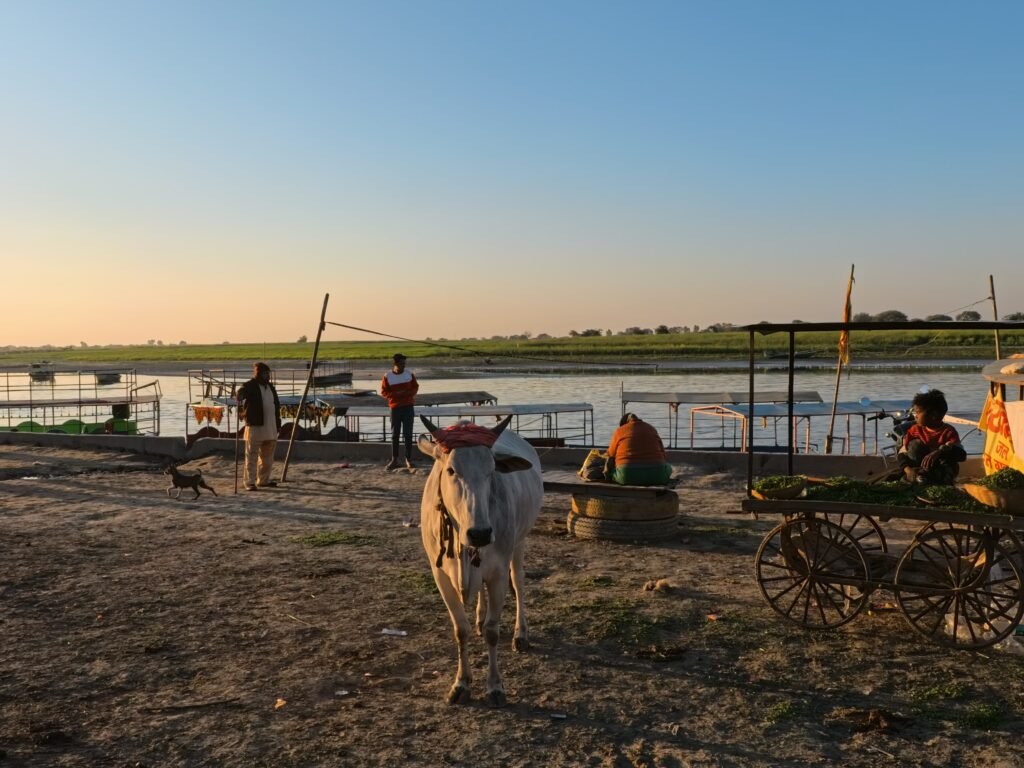
Madan Mohan Temple is one of the oldest and most revered in Vrindavan. Perched on a high hill by the Yamuna, it rises above the city like a sentinel. Built in the 16th century, it blends Rajput and Mughal styles, with red sandstone walls, delicate carvings, and arched entrances.
Standing at the foot of the temple and gazing at the curves of the Yamuna, along which fields of mustard stretch out, you can’t help but feel that same love and devotion that have kept Vrindavan alive for centuries.

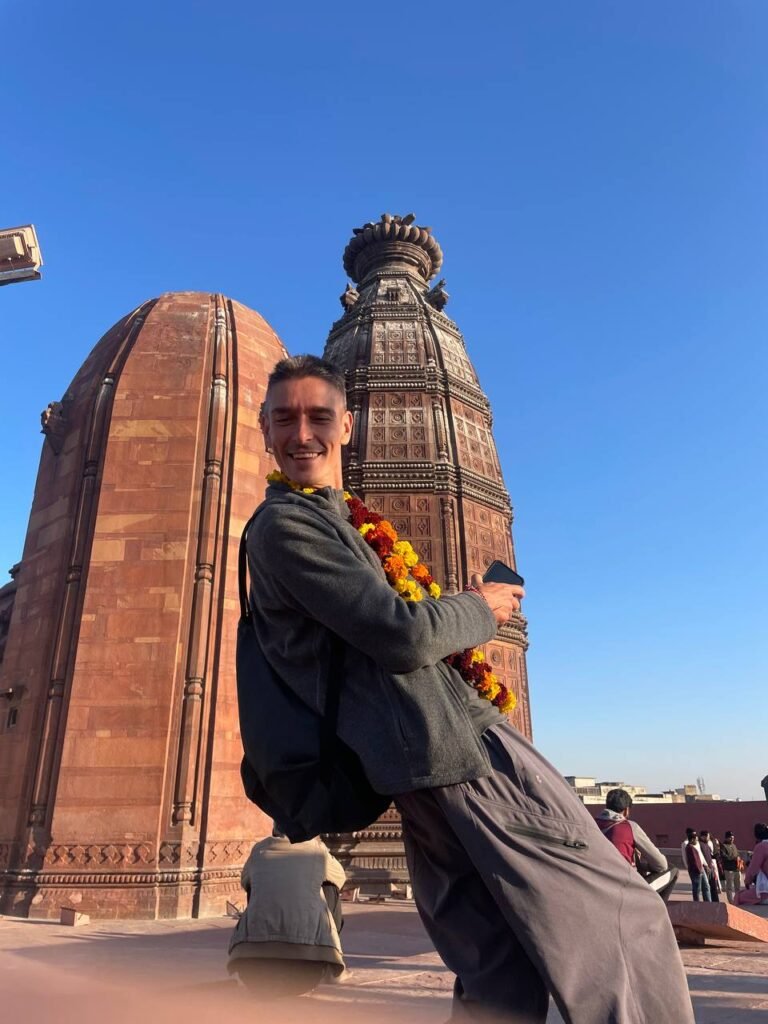
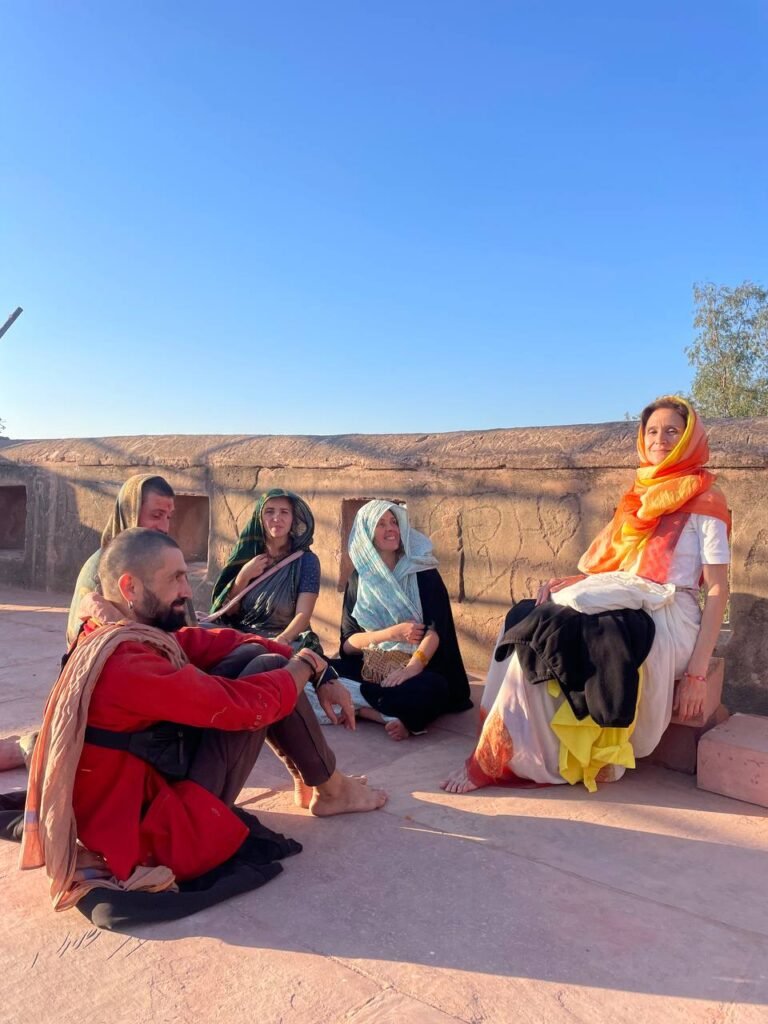
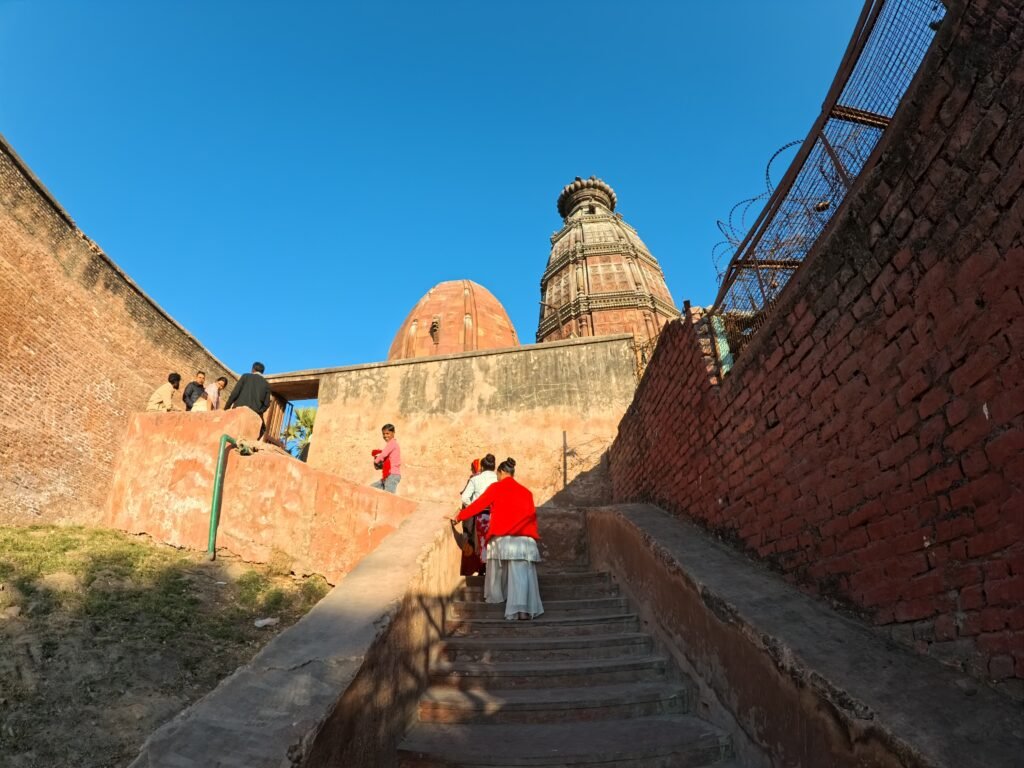
At the base of the temple, comfortably gathered in our small circle of traveling friends, we immersed ourselves in tales of a distant past — stories brought to life by Mykola. His calm humor and deep respect helped us avoid extremes in judgment.
Leaving Vrindavan: Between Mystery and Meaning
Leaving the temple, we walked along narrow winding streets crowded with stalls. Vendors called out to us, and the air was filled with bells.
Vrindavan is a city that exists not only in reality but also in the hearts of millions of devotees. It’s a place where the divine and the earthly meet in a continuous dance of faith and love.
Although I still found much that was strange and mysterious, I could not deny the power of the experience. Our journey through Vrindavan was just the beginning of a deeper exploration of India’s spiritual landscape—a journey that would challenge and change many of my preconceptions.
Articles in This Series
🌍 India Travel & Spiritual Journey Series
- The Word Was with God – How India Found Me
A personal and spiritual awakening begins in India’s heartland. - Delhi Shock – My First Night in India
Raw impressions from the chaotic, vibrant capital. - The Divine Heart of India – Vrindavan, Krishna, and Rama
A deep dive into sacred cities and mythic lore. - Madness or Faith? A Pilgrimage to Maha Kumbh Mela
Encountering the world’s largest religious gathering. - Exploring Hinduism’s Greatest Festival – Maha Kumbh Mela 2025
A guide and reflection on faith, crowds, and ritual. - To Be or Not to Be: On the Eve of the Great Bathing
Facing existential questions on the threshold of the sacred. - Where the Fires Burn – First Encounters with Varanasi
A visceral arrival in India’s most mystical city. - Between Life and Flame – Tales from the Ganges
Reflections on death, devotion, and the river’s eternal flame. - Journey Through Varanasi – Saturn, Sound, and Spirit
Myths, music, and meaning in India’s spiritual capital. - Puttaparthi: A Dream Made Real
A village transformed by faith: the story of Sathya Sai Baba’s birthplace. - At the Edge of the Universe – A Journey Through Puttaparthi
A cosmic path of devotion, silence, and the soul’s unfolding.
